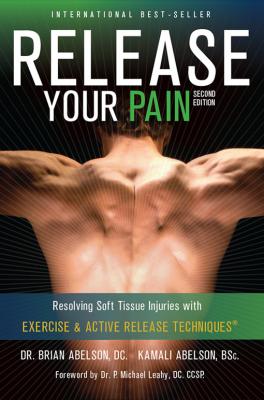ТОП просматриваемых книг сайта:
Release Your Pain: 2nd Edition - EBOOK. Dr. Brian James Abelson DC.
Читать онлайн.Название Release Your Pain: 2nd Edition - EBOOK
Год выпуска 0
isbn 9780987866219
Автор произведения Dr. Brian James Abelson DC.
Жанр Здоровье
Серия Release Your Body
Издательство Ingram
Soft-tissue injuries are so prevalent that most people suffer lingering effects of past soft-tissue injuries, without conscious awareness of its impact on their function and performance.
The best way to understand the compounding nature of soft-tissue injuries is to look at an example. For example, at our clinic, we commonly see patients who complain about back or knee problems.
During our evaluation, we often find that these patients also have a history of chronic foot or ankle problems. For example, an ankle sprain can cause a person to change the way they roll (pronate or supinate) their feet. This compensation then negatively affects the foot’s ability to act as a shock absorber as it flexes and rolls with each step.
Since most foot and ankle problems are not treated and rehabilitated correctly, the injured person often develops abnormal gait patterns and postural distortions as their body attempts to compensate for the restrictions caused by this soft-tissue injury.
If your feet are no longer correctly absorbing the force generated by walking or running, the excess force is redirected into other structures along your kinetic chain, including the knee and back.
This misdirected force/stress can easily cause a knee injury. The injured knee often causes even more compensations to occur throughout the body, leading to significant postural changes, decreased strength, lack of flexibility, and additional injuries throughout the body.
Note: The Kinetic Web can be thought of as a linked series of kinetic chains. Each kinetic chain is made up of individual links (your joints, bones, and soft tissues) which are connected to each other to form a Kinetic Web. Any weak link in this chain generates not only its own set of problems, but also creates problems and compensations along its entire 3-dimensional Kinetic Web.
When You Injure Your Body
Your body undergoes numerous biomechanical, physiological, and biochemical changes whenever you injure yourself. These include gait and motion compensations, stressed tissues, nerve impingements and all its accompanying effects, micro-tears causing further injuries, and numerous cardiovascular restrictions. This cause-and-effect sequence is summarized in this illustration.
Fig 1.1: Injury Escalation Cycle
The extensive array of possible soft-tissue injuries can overwhelm our health care system and are the cause of much pain and dysfunction.
But there is a realistic and effective solution for this problem. It is known as Active Release Techniques, and throughout the rest of this book we will be exploring the benefits and use of this treatment technique for the treatment and resolution of various types of soft-tissue injuries. This book will show you why these injuries occur, and how you can resolve them by combining specific exercise routines with treatments of Active Release Techniques.
Understanding Soft-Tissue Injuries
Chapter
2
How do Soft-Tissue Injuries Show Themselves?
A serious soft-tissue injury can develop within minutes after an injury occurs, or it may slowly develop over years. A soft-tissue injury is characterized by symptoms such as:
Aching.
Tenderness.
Swelling.
Pain.
Tingling and numbness.
Loss of strength.
Loss of joint movement.
Decreased coordination.
In general, your injury is more serious if the symptoms:
Are more intense.
Are experienced frequently.
Last longer with each occurrence.
Worsen with increased activity.
It is important to realize that symptoms:
May appear in any order and at any stage during the development of a soft-tissue injury.
May not appear during, or immediately after, the activity that is causing the problem.
Are not necessarily experienced at the body part where the actual stress is occurring. For example: Carpal Tunnel Syndrome (CTS) is often diagnosed as compression of the median nerve at the site of the carpal tunnel. In reality, many cases of CTS are due to median nerve compression in the forearm, shoulder, or even the neck.
How do Soft-Tissue Injuries Show Themselves?
Soft-tissue injuries manifest with a broad range of symptoms and conditions. Acute injury and inflammation can result from one or more of the following factors – even without any external forces being applied:
Inflammation - Acute injury, repetitive motion, or the friction involved in lack of translation of adhesed tissue creates inflammation.
Friction, Pressure and Tension - Friction, pressure, and tension are increased when muscles, tendons, ligaments, or connective tissue adhere together. We often think of these factors as external forces, but this is often not the case. Reduced levels of internal tissue translation is sometimes all that is needed to initiate a cycle of inflammation, which in turn can lead to an acute injury.
Adhesions and Fibrosis - Adhesions (scar tissue) and fibrosis (excessive fibrous connective tissue) are a common consequence of soft-tissue injuries, acute pressure, or constant tension. The breaking down of these adhesions and fibrous connective tissue is a key requirement of any treatment protocol that aims to resolve soft-tissue injuries.
Decreased Circulation and Increased Edema: The constant internal pressures caused by a soft-tissue injury limits circulation to the affected tissues, resulting in decreased delivery of oxygen. Decreased oxygen, or hypoxia, causes several biochemical changes in the body including increased production of mRNA and alpha-1 procollagen. These biochemical changes cause an increase in chemotaxis, proliferation of fibroblasts, and leads to the formation of adhesions and scar tissue1.
Cellular Hypoxia - Describes a lack of oxygen to soft-tissues that occurs whenever there is restricted circulation. Hypoxia causes fibrosis and results in the formation of adhesions between tissues.
Weak and Tight Tissues - Repetitive actions tend to make muscles tighten. A short and contracted muscle is a weak muscle. Normally, muscles are amazing structures which are able to store, release, and even recycle energy. They are also great shock absorbers and act to displace force which otherwise would cause injury. Unfortunately, the buildup of adhesions in your muscles causes them to lose both these abilities.
Tear

